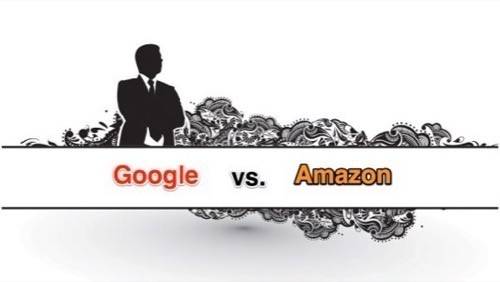
In this era where we think of “The Big Five” technology companies that dominate our computing experience, we tend to classify each company into its own distinct bucket. Facebook is the social giant, Apple is the runaway device maker, Google controls search and advertising, Amazon is the beast of e-commerce and content and Microsoft provides us productivity and business solutions. In reality, the lines between the five companies are not so clear cut.
Think of it like the Olympic rings logo as a Venn diagram. The top five companies share features with each other and compete in the same markets. For instance, Google versus Microsoft’s Bing. Or Apple’s iOS against Google’s Android against Microsoft’s Windows Phone. Facebook versus Google+. Apple’s Mac OS X versus Windows.

You might note a trend here where Google seems to be in everybody else’s space, to varying degrees of success. Google is still an advertising and search company at its core, but its scope continues to broaden.
Which brings us to the budding rivalry between Google and Amazon.
More so than any of the other five companies, Google and Amazon seem to be in a rush towards the center. Each is starting with a unique skill set (search versus e-commerce) but are continually expanding consumer and business features. From a broad perspective, Amazon has been better at diversifying its portfolio. Whereas Google still makes most of its money on advertising, Amazon has created revenue in addition to its traditional retail/book sales by expanding into media (Amazon Video On Demand and Kindle books), devices (Kindle e-readers and Fire tablets) and, most importantly, the cloud (Amazon Web Services). Google has moved into devices (its Nexus flagship Android devices and Motorola acquisition), cloud services (Google Apps and Drive), media and content (Google Play), developer services (Android) along with several pet projects that have yet to bear fruit like Google Wallet, Shopper etc.
Essentially, Google’s worldview still revolves around aggregating and providing access to the world’s information. Amazon’s center is to sell the world’s stuff. Increasingly, those objectives are bringing the companies to the same point in the ecosystem. Reuters today provides an interesting examination of the collision course between the two tech behemoths.
Let’s break down the categories where Google and Amazon are set to duke it out over the next several years.
Android & Devices
In 2011, Amazon created the template for how to cut into Apple’s iPad dominance by releasing the Kindle Fire at $199. Sales were good but not mind blowing. In 2012, Google took Amazon’s blueprint and one-upped it with the Nexus 7.
As we pointed out in June when the Nexus 7 Android tablet shipped, Google’s flagship tablet (made by ASUS) completely blew the original Kindle Fire out of the water. It was the same price but highly superior in terms of aesthetics and hardware as well as providing access to all of the apps in Google Play (as opposed to the somewhat limited supply from the Amazon Appstore for Android.

Amazon released the Kindle Fire HD and Fire HD 8.9 as updates to its tablets this year. This was not necessarily a response to Google, as the new Fire slates were likely in production by the time the Nexus 7 was announced. The Fire tablets are indeed of better quality then the original but were still bested by Google when it announced an update to the Nexus 7 along with the 10-inch Nexus 10 in late October.
Amazon’s subtle stick to Google is that the Fire tablets are based on a stripped-down version of Android. Since Google provides the core of Android for free, it is not making any money from Amazon for the devices. Amazon, in turn, has locked Google out of the Fire tablets, blocking access to Google Play and other Google services.
Apps & Media
The battle over devices directly informs the war for mobile media control (in which all five of the large tech corporations compete). In March this year, Google rebranded its Android Market to be Google Play and consolidated Google Music as well as its video and books capabilities. From the categories of media it offers, Google Play now looks very similar to what Amazon pushes through its Fire tablets.

Apps and app services are important to both companies. Amazon put a lot of effort into providing more capabilities and features to developers creating apps for the Appstore for Android this year than it had in 2011. This includes new maps capabilities (provided through Nokia), monetization and payment options and the like.
Google offers a variety of services to developers as a function of its place as the creator of Android. This includes a veritable book of best practices and services that can be found through the Android Developer Portal.
The Cloud
Amazon made a very important move in 2006 that proved to be a very good bet on the future of the Internet. It created Amazon Web Services, a cloud computing service where developers, businesses and individuals could rent space on Amazon servers to store information or provide computing power. AWS now runs a giant swath of the Internet and when one of its server farms goes down, the world goes into a bit of panic. According to research firm Forrester, AWS is by far the preferred cloud service for mobile developers.
Google has also long played in the cloud, but not on the same type of scale that AWS has become. Google Apps have essentially been Google’s cloud service including Docs, Gmail and infrastructure hosting for businesses. Google released Drive this year, its personal cloud locker for individuals. Whereas AWS is a billion-dollar vertical for Amazon, Google’s cloud services are a drop in the pond compared to its advertising revenue.
Advertising War Heats Up
As Reuters points out in its analysis of the two companies today, Amazon is beginning to move into the advertising realm with its “DSP” technology that analyzes what consumers purchase and what they are looking to purchase through Amazon.com. According to Reuters, analyst firm Robert W. Baird & Co. estimates Amazon’s advertising revenue in 2012 at $500 million. That is a small fraction of what Google makes in revenue from advertising in a year.
This is where the battle between Google and Amazon gets interesting: the meta layer of data attempting to gauge consumer intent. Google wants to provide system and structure to the world’s information and that includes information about its users. It can then use that information to create better experiences and advertising. Amazon’s information is more direct, based on the data it collects from its users who make actual transactions. Google has long tried to push into this transactional realm, but none of its attempts have taken off. On the other hand, Amazon would probably love to be able to create the same type of data on its users that Google has been able to create.
Unedited lead image courtesy of Shutterstock
Unedited Olympic Logo courtesy by Wikipedia










